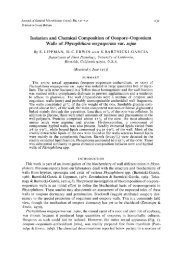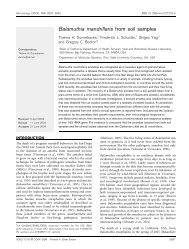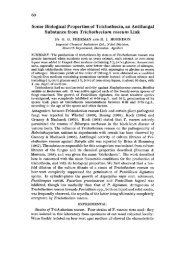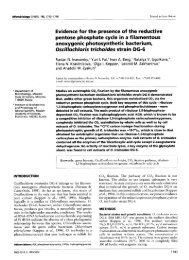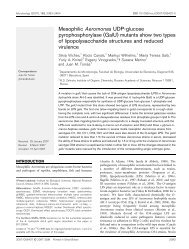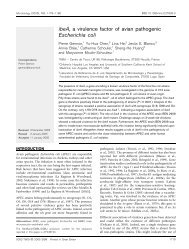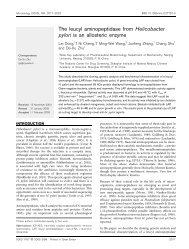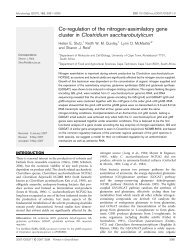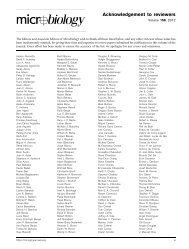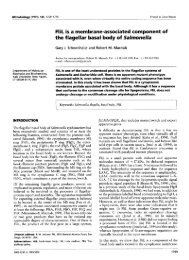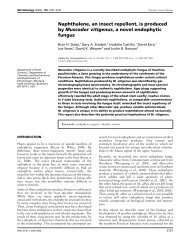The Characterization of Hyalochlorella marina gen. et ... - Microbiology
The Characterization of Hyalochlorella marina gen. et ... - Microbiology
The Characterization of Hyalochlorella marina gen. et ... - Microbiology
Create successful ePaper yourself
Turn your PDF publications into a flip-book with our unique Google optimized e-Paper software.
<strong>Characterization</strong> <strong>of</strong> <strong>Hyalochlorella</strong> <strong>marina</strong> I75<br />
the HCl hydrolysis step was omitted. No stained bodies were seen in either<br />
control,<br />
Variation in number <strong>of</strong> autospores. <strong>The</strong> number <strong>of</strong> daughters (autospores) produced<br />
per mother (sporangium) was d<strong>et</strong>ermined by observing microcolony development on<br />
slides coated with GDY agar (Skerman, 1967). Agar-coated slides were stored on the<br />
surface <strong>of</strong> a GDY agar P<strong>et</strong>ri plate at 4" until needed. <strong>The</strong>y were inoculated at 20"<br />
from early exponential phase GDY liquid cultures and incubated 40 to 48 h. Sporangial<br />
bursts were scored microscopically either immediately after incubation or after<br />
storage at 4" for no more than 10 h.<br />
Cytological observations. Cellulose in the wall was d<strong>et</strong>ermined by the zinc-chlor-<br />
iodide m<strong>et</strong>hod <strong>of</strong> Rawlins & Takahashi (1952) and the IKI-H,S04 m<strong>et</strong>hod <strong>of</strong> Johansen<br />
(1940). Pectic wall substances were d<strong>et</strong>ected by the Ruthenium Red m<strong>et</strong>hod as<br />
described by Kessler & Soeder (1962). Capsules and gelatinous matrices surrounding<br />
organisms were d<strong>et</strong>ermined by negative staining in indian ink. Exponentially<br />
growing cells from a vari<strong>et</strong>y <strong>of</strong> media were tested.<br />
<strong>The</strong> presence and localization <strong>of</strong> intracellular starch was d<strong>et</strong>ermined by making<br />
w<strong>et</strong> mounts <strong>of</strong> both fixed and unfixed organisms in IKI. <strong>Hyalochlorella</strong> and spontaneous<br />
colourless mutants <strong>of</strong> Chlorella were fixed in Carnoy's ac<strong>et</strong>ic acid-alcohol ; Prototheca<br />
was fixed in 10 % (v/v) formalin. In all cases, fixed and unfixed organisms gave similar<br />
results. Intracellular lipid granules were stained with Sudan Black as described by<br />
Burdon (1946). Organisms were taken from exponential and stationary phase cultures<br />
grown on GDY agar and GDY agar plus 2 % (wfv) glucose.<br />
Vacuoles and refractile granules in exponentially growing cells were observed in<br />
w<strong>et</strong> mounts by phase contrast microscopy.<br />
Photomicrography. All photomicrographs except P1. I, fig. 2 were taken on<br />
Adox KB14 35 mm. film through a Leitz Ortholux microscope equipped with<br />
apochromatic phase contrast objectives and a Heine condenser. For P1. I, fig. 2,<br />
Ultropak achromatic objectives with ring condensers were used and dark-field<br />
reflected light illumination was provided by an Ultropak illuminator.<br />
Production <strong>of</strong> extracelhlar enzymes. Extracellular enzymes were sought by replica<br />
plating (Lederberg & Lederberg, 1952) as described by Stanier, Palleroni & Doudor<strong>of</strong>f<br />
(1966). A s<strong>et</strong> <strong>of</strong> master plates were prepared on GDY medium rehydrated with tap<br />
water for Prototheca strains and with sea water for <strong>Hyalochlorella</strong> strains and colour-<br />
less mutants <strong>of</strong> Chlorella. <strong>The</strong>y were patched with 15 strains and incubated for I week.<br />
One master plate served to print 12 test plates.<br />
Extracellular gelatinase production was d<strong>et</strong>ermined as described by Skerman<br />
(1967): gelatin, 5 % (wlv), was added to yeast extract (Difco), 0.5 % (w/v); K,HPO,,<br />
0.1 % (w/v); MgS0,.7H20, 0.02 % (w/v); Ionagar (Oxoid), 1.0 % (w/v); tap water<br />
or sea water. Each strain was replicated in duplicate. One s<strong>et</strong> was flooded with<br />
acidic mercuric chloride after 5 days and the other after 10 days <strong>of</strong> incubation. Only<br />
strains which showed a clear zone extending beyond the limits <strong>of</strong> growth were scored<br />
as positive. Gelatin liquefaction was assessed in 12-8 % (w/v) Difco nutrient gelatin.<br />
<strong>The</strong> stab was examined for liquefaction periodically over 2 weeks.<br />
Extracellular lipase was d<strong>et</strong>ermined by the m<strong>et</strong>hod <strong>of</strong> Sierra (1957). After sterilization,<br />
the peptone medium was supplemented with I % (w/v) polyoxy<strong>et</strong>hylene (20) sorbitan<br />
mono-oleate (Tween 80) and the pH was adjusted to 7-2. Observations were made<br />
over 8 days.<br />
I2 MIC 62



